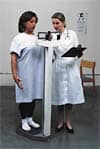Researchers investigate how timing and density of EEG segments differ among patients with narcolepsy type 1, narcolepsy type 2, idiopathic hypersomnia, and controls.
When providers come across patients who show signs of excessive sleepiness and frequent daytime sleep attacks, diagnostic tests like polysomnogram (PSG) and multiple sleep latency tests (MSLTs) help screen for idiopathic hypersomnia and narcolepsy. But as numerous studies and narcolepsy patient accounts have shown, even MSLTs can show invalid results that can create missed opportunities for proper diagnosis.
Given that there are still challenges in correctly diagnosing and treating patients for hypersomnia and narcolepsy, researchers like Alyssa Cairns, PhD, at SleepMed looked for new ways to parse through sleep study data to better understand the sleep structure in narcolepsy and other hypersomnias. Last year, Cairns published a study that looked at the microarchitecture of patient groups with differing hypersomnias. Using electroencephalogram (EEG) data, she and her colleagues found that the sleepiness symptoms narcolepsy patients presented differed from the symptoms patients with idiopathic hypersomnia showed.
Since then, she has looked further into the 200 EEG results of SleepMed’s deidentified data repository to see how the timing and density of EEG segments in hypersomnias differed among patients with narcolepsy type 1, narcolepsy type 2, idiopathic hypersomnia, and clinic control patients. In 2018, she co-published her study titled, “Timing And Density Of EEG Segments In The Hypersomnias: Implications For Circadian And Homeostatic Control Of Sleep.”
“We took a closer look at these EEGs and focused on the abnormalities we saw in circadian timing and homeostatic regulation function among these different groups of patients,” Cairns says.
Cairns and her colleagues found that patients with narcolepsy had elevated homeostatic regulation of REM at the beginning of the night that quickly dropped off, which explains why patients with narcolepsy have a lot of occurrences of discontinued sleep at night. Patients with idiopathic hypersomnia appeared to have normal circadian timing of REM but altered homeostatic regulation that suggests increased deep sleep and/or reduced homeostatic efficiency.
The findings of this study emphasize the importance of taking into account the robust information that PSGs can tell providers about the abnormality of the patient’s sleep regulation processes. In other words, don’t just rely on the results of the MSLT to rule out narcolepsy with absolute certainty.
“Polysomnograms can reveal potential underlying mechanisms of abnormality. So for instance, if you someone with relatively early timed rapid eye movement processes on their PSG but their MSLT is normal or consistent with idiopathic hypersomnia for example, don’t just stop there but instead re-administer the MSLT,” Cairns says.
Because the MSLT is subject to high test unreliability, especially concerning narcolepsy type 2 and idiopathic hypersomnia, clinicians should rely on their clinical expertise to redo tests to gather more clinical correlation to get patients a more reliable, accurate diagnosis.
“Our nocturnal polysomnogram data has shown us that there are some characteristics where patients with narcolepsy cluster on demonstrating consistent abnormal REM processes and polysomnograms can corroborate abnormal REM phenomenon,” Cairns says.
Unlike narcolepsy type 1, idiopathic hypersomnia is not quite easy to assess, and the margins of error of diagnosing this condition are huge, which makes it like “the wild, wild west that needs more investigation,” according to Cairns.
The biggest takeaway for providers and patients is that when in doubt, consider retaking the MSLT. Given that it still takes years for narcolepsy to get a proper diagnosis from the moment of onset, it just makes sense to not only ignore symptoms of excessive daytime sleepiness but rather gather additional data that can led to a more precise diagnosis.
Yoona Ha is a freelance writer and healthcare public relations professional.





Hello I have narclopsey with cataplexy, I was diagnosed 4years ago. I live in Tennessee but I can not find a doctor to treat me. Any ideas or help for me please.
April, there are some Tennessee specialists listed here that might offer some options for you.
https://www.hypersomniafoundation.org/healthcare-provider-directory/
Keeping good thoughts for you as you make your way to supportive care and best fit treatment options.
~Beth
P.S. My diagnosis is IH/Idiopathic Hypersomnia but like you, I understand the #beyondsleepy struggle